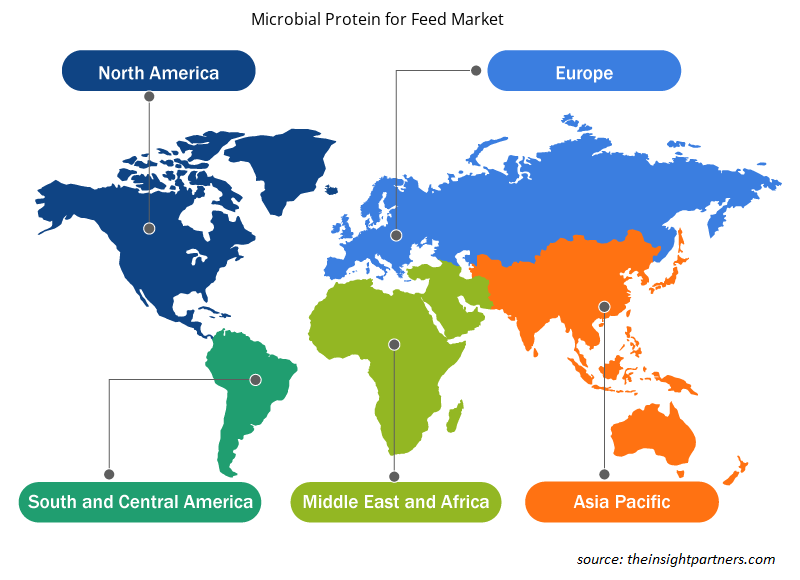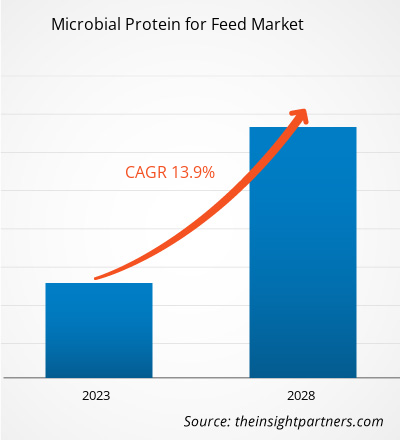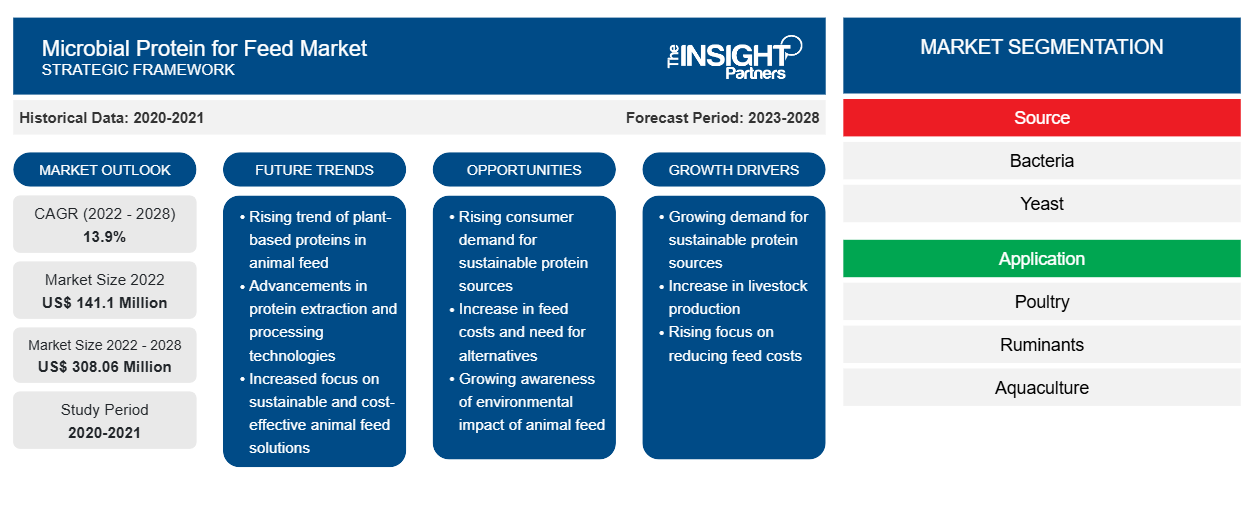Si prevede che il mercato delle proteine microbiche per mangimi crescerà da 141.095,88 mila dollari USA nel 2022 a 308.055,17 mila dollari USA entro il 2028; si stima che registrerà un CAGR del 13,9% dal 2022 al 2028.
Le proteine microbiche sono una delle fonti significative di proteine grezze. Ci sono molti benefici nutrizionali nell'includere le proteine microbiche nei mangimi per animali . Le proteine microbiche contengono più del 70% di proteine grezze, mentre la farina di soia contiene il 40-50% di proteine grezze e la farina di pesce contiene il 60-65% di proteine grezze. Inoltre, ha un profilo aminoacidico ideale, tra cui valina, triptofano, isoleucina e leucina più elevati rispetto alle farine di pesce. Le proteine microbiche sono una delle eccellenti alternative alle fonti convenzionali di proteine come la soia e la farina di pesce. Sono prodotte utilizzando substrati convenienti come gas industriali (anidride carbonica, metano e gas naturale), acque reflue e rifiuti di pollame (piume) fermentati in un reattore utilizzando batteri, lieviti, funghi o microalghe. Pertanto, vari benefici nutrizionali nell'aggiungere proteine microbiche alle diete del bestiame e le crescenti preoccupazioni sulla sostenibilità stanno guidando la crescita del mercato delle proteine microbiche per i mangimi .
Nel 2021, l'Europa ha detenuto la quota maggiore del mercato globale delle proteine microbiche per mangimi. Secondo la European Feed Manufacturers' Federation (FEFAC), la produzione di mangimi per suini è aumentata del 2,9% nel 2020, nonostante la continua diffusione della peste suina africana (PSA) nella regione e il suo impatto sull'allevamento di suini. Diversi paesi europei hanno aumentato le loro esportazioni verso la Cina, beneficiando del divieto di esportazione della Germania, che ha portato a un'impennata della produzione di mangimi per suini nel 2020. Con i crescenti livelli di produzione di mangimi per animali, i produttori sono alla ricerca di additivi per mangimi sostenibili, poiché gli additivi per mangimi di origine animale e vegetale non sono percepiti come rispettosi dell'ambiente al giorno d'oggi. Le materie prime per mangimi importate, come la soia, minacciano le risorse naturali e la biodiversità. Pertanto, la domanda di proteine microbiche è in aumento tra i produttori di mangimi per animali.
Personalizza questo report in base alle tue esigenze
Riceverai la personalizzazione gratuita di qualsiasi report, comprese parti di questo report, o analisi a livello nazionale, pacchetto dati Excel, oltre a usufruire di grandi offerte e sconti per start-up e università
-
Scopri le principali tendenze di mercato in questo rapporto.Questo campione GRATUITO includerà analisi di dati che spaziano dalle tendenze di mercato alle stime e alle previsioni.
Impatto della pandemia di COVID-19 sul mercato delle proteine microbiche per mangimi
L'industria dei mangimi ha dovuto affrontare sfide cruciali come la carenza di materie prime e manodopera, un'impennata dei prezzi delle materie prime e interruzioni nelle reti di distribuzione dovute a lockdown, divieti di viaggio, limitazioni commerciali, chiusure di unità produttive e altre restrizioni imposte dal governo in tutto il mondo. Ciò ha ostacolato le attività di produzione di varie aziende nel settore dei mangimi per animali, con conseguente aumento dei prezzi degli ingredienti per mangimi. Nell'Unione Europea, circa due terzi degli stati membri hanno sottolineato l'impennata dei prezzi dei mangimi nel settore zootecnico durante la pandemia. Inoltre, durante il picco della pandemia, la Cina ha chiuso i mercati di commercio e macellazione di bestiame e pollame nella maggior parte delle regioni. Tali barriere nel settore zootecnico hanno ostacolato la domanda di ingredienti per mangimi, il che ha avuto un impatto negativo sulla domanda di proteine microbiche per mangimi durante la pandemia.
Nel 2021, varie economie hanno ripreso le operazioni poiché i loro governi hanno annunciato allentamenti nelle restrizioni precedentemente imposte, il che ha dato impulso al mercato globale. Inoltre, ai produttori è stato consentito di operare a piena capacità, il che li ha aiutati a superare il divario tra domanda e offerta e altre ripercussioni.
Approfondimenti di mercato
Gli investimenti del governo e del settore privato avranno un impatto positivo sulla crescita del mercato delle proteine microbiche per i mangimi
Il cambiamento climatico e lo sfruttamento eccessivo di risorse naturali come terra e acqua sono le principali preoccupazioni per la sostenibilità nel settore dell'allevamento e dei mangimi per animali. Di conseguenza, i governi di vari paesi in tutto il mondo stanno finanziando aziende che producono mangimi e ingredienti per animali utilizzando pratiche sostenibili per ridurre la loro impronta di carbonio complessiva e supportare la crescita dell'economia circolare. Anche i governi e gli investitori del settore privato stanno supportando le aziende che producono proteine per mangimi animali da microrganismi, poiché rappresentano una delle fonti di proteine più sostenibili per l'alimentazione animale. Ad esempio, a febbraio 2022, Arbiom, un produttore franco-americano di proteine di alta qualità per mangimi e applicazioni alimentari mediante la lavorazione di rifiuti agricoli e residui di legno, ha ricevuto un investimento di 13,50 milioni di dollari dal programma di investimento France Relance. Dopo aver ricevuto l'investimento, l'azienda ha annunciato la costruzione del suo primo impianto di produzione commerciale in Francia. Pertanto, si prevede che i crescenti investimenti del governo e del settore privato nel mercato delle proteine microbiche per mangimi avranno un impatto positivo sulla crescita del mercato nel periodo di previsione.
Informazioni sulla fonte
In base alla fonte, il mercato globale delle proteine microbiche per mangimi è segmentato in batteri, lieviti e altri. Il segmento dei batteri ha detenuto la quota maggiore del mercato globale delle proteine microbiche per mangimi nel 2021 e si prevede che registrerà il CAGR più elevato dal 2022 al 2028. I batteri presentano i tassi di crescita più elevati rispetto al lievito e ad altri microrganismi. Inoltre, la quantità di proteine prodotte utilizzando la coltura batterica è la più grande. Inoltre, ha più del 70% di proteine grezze e ha un profilo di aminoacidi essenziali favorevole. Secondo vari studi, 1.000 kg di batteri producono una qualità di proteine maggiore rispetto alla soia e ai bovini da carne. Pertanto, i batteri sono una delle fonti di proteine più economiche e rapide per i mangimi animali. Tutti questi fattori stanno guidando il mercato per il segmento.
I principali attori che operano nel mercato globale delle proteine microbiche per mangimi includono Calysta, Inc.; Avecom; Arbiom; KnipBio; ICC; e Alltech. Gli attori del mercato si stanno concentrando sulla fornitura di prodotti di alta qualità per soddisfare la domanda dei clienti. Si stanno inoltre concentrando su strategie quali investimenti in attività di ricerca e sviluppo, partnership ed espansione.
Proteine microbiche utilizzate nei mangimi
Approfondimenti regionali sul mercato delle proteine microbiche per mangimi
Le tendenze regionali e i fattori che influenzano il mercato delle proteine microbiche per mangimi durante il periodo di previsione sono stati ampiamente spiegati dagli analisti di Insight Partners. Questa sezione discute anche i segmenti e la geografia del mercato delle proteine microbiche per mangimi in Nord America, Europa, Asia Pacifico, Medio Oriente e Africa e America meridionale e centrale.

- Ottieni i dati specifici regionali per il mercato delle proteine microbiche per mangimi
Ambito del rapporto di mercato sulle proteine microbiche per mangimi
| Attributo del report | Dettagli |
|---|---|
| Dimensioni del mercato nel 2022 | 141,1 milioni di dollari USA |
| Dimensioni del mercato entro il 2028 | 308,06 milioni di dollari USA |
| CAGR globale (2022 - 2028) | 13,9% |
| Dati storici | 2020-2021 |
| Periodo di previsione | 2023-2028 |
| Segmenti coperti |
Per fonte
|
| Regioni e Paesi coperti |
America del Nord
|
| Leader di mercato e profili aziendali chiave |
|
Proteine microbiche per i giocatori del mercato dei mangimi Densità: comprendere il suo impatto sulle dinamiche aziendali
Il mercato delle proteine microbiche per mangimi sta crescendo rapidamente, spinto dalla crescente domanda degli utenti finali dovuta a fattori quali l'evoluzione delle preferenze dei consumatori, i progressi tecnologici e una maggiore consapevolezza dei benefici del prodotto. Con l'aumento della domanda, le aziende stanno ampliando la propria offerta, innovando per soddisfare le esigenze dei consumatori e capitalizzando sulle tendenze emergenti, il che alimenta ulteriormente la crescita del mercato.
La densità degli operatori di mercato si riferisce alla distribuzione di aziende o società che operano in un particolare mercato o settore. Indica quanti concorrenti (operatori di mercato) sono presenti in un dato spazio di mercato in relazione alle sue dimensioni o al valore di mercato totale.
Le principali aziende che operano nel mercato delle proteine microbiche per mangimi sono:
- Società a responsabilità limitata
- Avecom
- Arbiom
- KnipBio
- CCI
Disclaimer : le aziende elencate sopra non sono classificate secondo un ordine particolare.

- Ottieni una panoramica dei principali attori del mercato delle proteine microbiche per mangimi
Sviluppo chiave:
A giugno 2022, Calysta Inc. e Adisseo hanno costituito una joint venture (JV), "Calysseo", per avviare il loro primo impianto di produzione su scala industriale a Chongqing, in Cina, per produrre 20.000 tonnellate di FeedKind, una proteina microbica per mangimi per acquacoltura, all'anno. Con la produzione e la distribuzione di successo di FeedKind in Cina, i partner della JV stanno pianificando di espandere la capacità produttiva a 80.000 tonnellate all'anno nei prossimi anni.
Segnala i riflettori
- Tendenze industriali progressive nel mercato delle proteine microbiche per mangimi per aiutare gli operatori a sviluppare strategie efficaci a lungo termine
- Strategie di crescita aziendale adottate dai paesi sviluppati e in via di sviluppo
- Analisi quantitativa del mercato delle proteine microbiche per mangimi dal 2020 al 2028
- Stima della domanda globale di proteine microbiche per mangimi
- Analisi PEST per illustrare i fattori politici, economici, sociali e tecnologici che influenzano la crescita del mercato globale delle proteine microbiche per mangimi.
- Sviluppi recenti per comprendere lo scenario competitivo del mercato
- Tendenze e prospettive di mercato, nonché fattori che guidano e frenano la crescita del mercato delle proteine microbiche per mangimi
- Assistenza nel processo decisionale evidenziando le strategie di mercato che sostengono l'interesse commerciale, portando alla crescita del mercato
- Dimensioni del mercato dei prodotti autoabbronzanti in vari nodi
- Panoramica dettagliata e segmentazione del mercato, nonché dinamiche del settore delle proteine microbiche per mangimi
- Dimensioni del mercato delle proteine microbiche per mangimi in varie regioni con promettenti opportunità di crescita
- Analisi storica (2 anni), anno base, previsione (7 anni) con CAGR
- Analisi PEST e SWOT
- Valore/volume delle dimensioni del mercato - Globale, Regionale, Nazionale
- Industria e panorama competitivo
- Set di dati Excel
Report recenti
Rapporti correlati
Testimonianze
Motivo dell'acquisto
- Processo decisionale informato
- Comprensione delle dinamiche di mercato
- Analisi competitiva
- Analisi dei clienti
- Previsioni di mercato
- Mitigazione del rischio
- Pianificazione strategica
- Giustificazione degli investimenti
- Identificazione dei mercati emergenti
- Miglioramento delle strategie di marketing
- Aumento dell'efficienza operativa
- Allineamento alle tendenze normative























 Ottieni un campione gratuito per - Proteine microbiche per il mercato dei mangimi
Ottieni un campione gratuito per - Proteine microbiche per il mercato dei mangimi